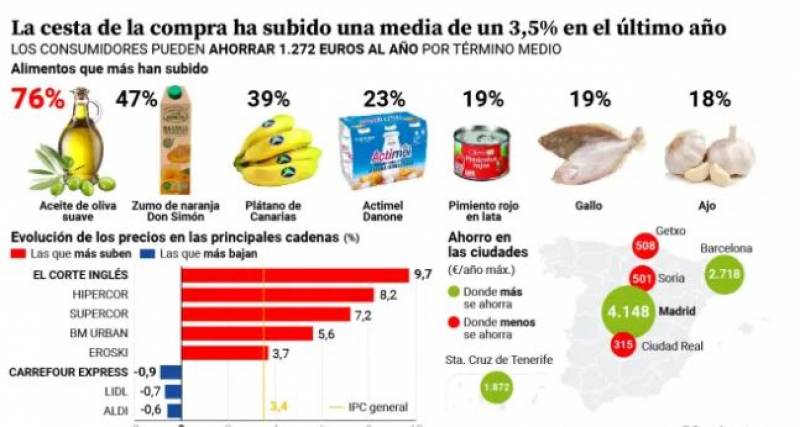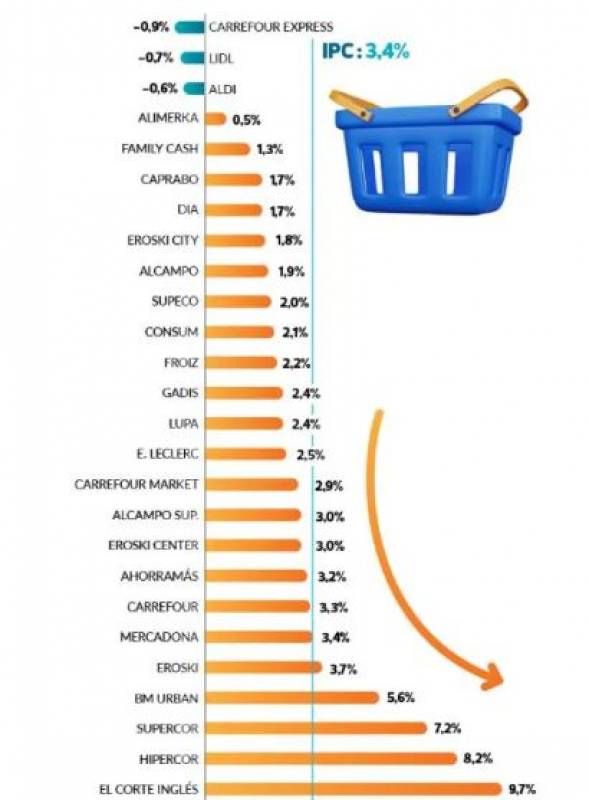The rising cost of groceries: Navigating food prices in Spain
Prices have increased in six out of ten products across Spain over the last year

For many families across Spain, grocery shopping has become a daunting challenge. While food inflation has shown signs of easing with a modest drop to 2.5% in August, the reality remains that filling the shopping trolley is still more expensive than this time last year.
On average, food prices increased by 3.5% over the past 12 months, but the cumulative rise since 2021 is a staggering 35.5%. This sharp increase has significantly impacted purchasing power, forcing families to rethink their shopping habits.
A recent report from the Organisation of Consumers and Users (OCU) sheds light on these trends, based on an extensive analysis of 155,489 prices across 1,070 shops in 65 cities, including online supermarkets. The study focused on a basket of 238 essential items, spanning 16 categories, from fresh produce to packaged foods and hygiene products.
“Over the past year, prices have been contained. They have stopped rising as much. But that doesn't mean that consumers have it any easier now. Many families have stopped eating meat or fish because prices remain at very high levels,” said Ileana Izverniceanu, director of communications for OCU.

The data reflects a troubling shift in dietary habits: with many households now spending a larger percentage of their budgets just to buy the same basket of groceries, nutritional quality is taking a hit.
“Many households have been forced to buy more processed products and fewer fresh products,” Ms Izverniceanu added.
Despite some prices falling, the report reveals that six out of ten items have seen increases in 2024. For instance, extra virgin olive oil prices have surged by an astonishing 80.2%. Other notable increases include Don Simón orange juice at +47.3% and Canary Islands bananas at +38.5%.
On a positive note, some products have seen significant price drops, such as sunflower oil (-23.1%), salad tomatoes (-20.9%) and margarine (-18%).
As families seek budget-friendly options, white label products have become increasingly popular. However, even these alternatives have seen an average price increase of 2.8%, only slightly lower than branded products.
 Interestingly, for the first time since 2021, a few supermarket chains have reduced their prices. Carrefour Express, Lidl and Aldi all reported minor price decreases, while others, like Supercor and El Corte Inglés, have significantly raised their prices, with increases of 7.2% and 9.7%, respectively.
Interestingly, for the first time since 2021, a few supermarket chains have reduced their prices. Carrefour Express, Lidl and Aldi all reported minor price decreases, while others, like Supercor and El Corte Inglés, have significantly raised their prices, with increases of 7.2% and 9.7%, respectively.But the most cost-effective option for shoppers was found to be the supermarket chain Alcampo, with the stores in Barcelona, Vigo and the city of Murcia coming in the top three positions.
As for the autonomous communities, Galicia is the cheapest region for grocery shopping, followed by La Rioja, the Valencian Community, Castilla y León, Extremadura and Andalucía, while Madrid, the Basque Country, the Balearic Islands and the Canary Islands are the most expensive.
Given these rising prices, the OCU has called on the government to extend VAT reductions on meat and fish and to increase the reach of food vouchers for those in need.
In addition, it has asked the CNMC and the Ministry of Agriculture to “ensure that the reduction in production costs is passed on to consumers at the same speed as the increases in recent years, avoiding extraordinary profits to the detriment of consumers.”
Images: Freepik/OCU
Loading
Sign up for the Spanish News Today Editors Roundup Weekly Bulletin and get an email with all the week’s news straight to your inbox
Special offer: Subscribe now for 25% off (36.95 euros for 48 Bulletins)
OR
you can sign up to our FREE weekly roundup!
Read some of our recent bulletins:
Discount Special Offer subscription:
36.95€ for 48 Editor’s Weekly News Roundup bulletins!
Please CLICK THE BUTTON to subscribe.
(List price 3 months 12 Bulletins)
Read more stories from around Spain:
Contact Spanish News Today: Editorial 966 260 896 /
Office 968 018 268































